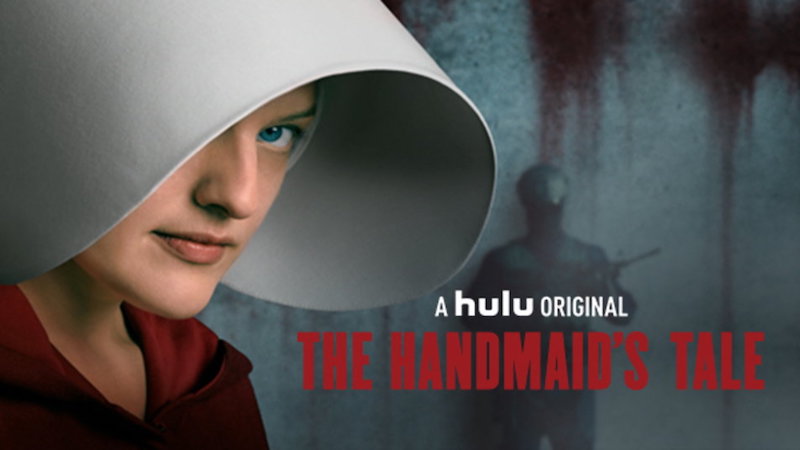The Handmaid’s Tale: Is The Handmaid’s Tale Feminist? (What Is Feminism?)
Episode #9 of the course Sci-Phi: Philosophy through science fiction by David Kyle Johnson, PhD
Hulu’s The Handmaid’s Tale is based on a 1985 novel by Margaret Atwood, which is set in a not-too-distant future where a puritan uprising has overthrown the US government. Not only are abortion and homosexuality capital offenses in the “Republic of Gilead,” but all women have been stripped of the right to vote, own property, or have money. Indeed, due to drastic drops in the birthrate, fertile women have been rounded up to serve as “handmaids” for the commanders of the religious regime. They rape the handmaids while they lay between the legs of their wife, in hopes that they will bear them children. The story follows a handmaid named June.
The Handmaid’s Tale has garnered public attention like few sci-fi stories have because of serious worries that something like it could actually happen. As Atwood herself put it to the New York Times, “‘It can’t happen here’ [can’t] be depended on. Anything [can] happen anywhere, given the [right] circumstances.” Indeed, Atwood did not “put any events into the book that had not already happened in what James Joyce called the ‘nightmare’ of history.” Governments have been toppled, and women have been treated in exactly the ways it describes.
Is The Handmaid’s Tale Pro-Feminism?
Despite this, Atwood has insisted that the story is no more feminist than any other story in which “women are human beings … and are also interesting and important.” But since, as we’ve discussed, authorial intention doesn’t define meaning, whether The Handmaid’s Tale is pro-feminist is an open question. And one can see why the answer seems to be yes: The story seems to endorse the ideas and goals of the recognized three waves of feminism.
Take the first wave of feminism, which began in the mid-1800s and was championed by Elizabeth Cady Stanton. It’s most commonly associated with suffrage—the fight to get women the right to vote, which it accomplished in 1920. But it also fought against slavery and for women to have the right to own property, have a job, have money, and equal access to divorce. And since all of those things have been stripped from women in Gilead, one moral message of the story must be to not take the accomplishments of the first wave for granted.
Fighting the Second Wave?
By the 1960s, it became clear that gaining the right to vote wasn’t going to give women the social equality that the first wave of feminism had aimed for, and so a second wave emerged. Specifics about second-wave feminism might provide the key to discovering why Atwood doesn’t want to call her novel feminist. In short, some second-wave feminists fought for things that Atwood didn’t agree with: like Susan Brownmiller, who argued that women shouldn’t wear dresses or lipstick; Page Mellish, who said that that pornography should be banned; or Kate Millett, who seemed to think, like June’s mother, that men are good for nothing except “ten seconds’ worth of half babies.” Since all of these ideas are vilified by The Handmaid’s Tale, one could argue that it is actually against second-wave feminism.
But this interpretation, and Atwood’s understanding of second-wave feminism, is inaccurate. These ideas only existed on the fringe, and the second wave was much more about ideas that The Handmaid’s Tale is sympathetic toward: women in the workforce, equal pay and protection under the law, reproductive rights, and sexual freedom—the women’s liberation movement. Indeed, second-wave feminism was famous for its suggestion that society (especially beauty pageants) treated women like cattle. In The Handmaid’s Tale, handmaids are overtly treated like cattle; they even have tagged ears and are shocked by cattle prods.
Riding the Third Wave?
The extent to which The Handmaid’s Tale aligns with third-wave feminism is difficult to pin down because third-wave feminism itself is difficult to pin down. In general, I’d say it is. Like the Hulu series, third-wave feminism is notoriously more diverse than its predecessors. And when the cast of the Hulu series refused to say it was feminist, that may have made it align with third-wave feminism more than anything else … because if third-wavers are known for anything, it’s not telling others how to be feminists.
But the threat that The Handmaid’s Tale may one day become a reality raises another question: Will good inevitably triumph over evil? If it did, how could we tell? What’s the difference between good and evil? Should we move beyond it? To answer that question and finish up, tomorrow, we are going to bring it back around to Star Wars.
Recommended reading
“Margaret Atwood on What ‘The Handmaid’s Tale’ Means in the Age of Trump” by Margaret Atwood
Recommended book
The Handmaid’s Tale by Margaret Atwood
Share with friends

